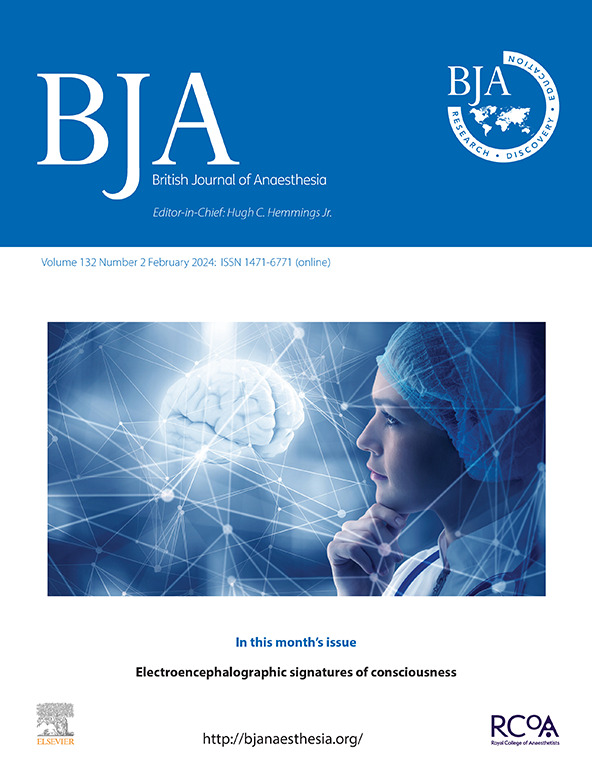Description and validation of the Postoperative Discharge Recovery State outcome: a patient-partnered population-based cohort study.
IF 9.2
1区 医学
Q1 ANESTHESIOLOGY
引用次数: 0
Abstract
BACKGROUND Older adults prioritise independent return home after surgery. Most discharge outcomes are binary composites that do not incorporate temporal information. We defined and validated a novel ordinal outcome, the Postoperative Discharge Recovery State, and prioritised its temporal measurement, to overcome these limitations. METHODS This retrospective cohort study was conducted with patient partnership. Adults ≥65 yr having major, elective, noncardiac, non-orthopaedic surgery were identified from 2012 to 2022 using linked, routinely collected data in Ontario, Canada. Construct, convergent, and predictive validity were estimated. A multivariable ordinal regression model was derived and internally-externally validated. RESULTS We included 84 422 older adult surgical patients. At the patient-prioritised postoperative day 90, the distribution of patients across Postoperative Discharge Recovery State categories was: (1) dead (2718; 3.2%); (2) hospitalised (1696; 2.0%); (3) in long-term care (179; 0.2%); (4) in rehabilitation (593; 0.7%); and (5) at home (79 236; 93.9%). Directionally expected associations with baseline characteristics supported construct validity. Consistency in associations over time supported reliability. Relationships with days alive and at home supported convergent (ρ=0.373) and predictive (fewer days at home with worse recovery state) validity. A prespecified ordinal logistic regression model had inadequate accuracy (c-statistic 0.700, poor calibration) to support its clinical use. CONCLUSIONS The Postoperative Discharge Recovery State is a 5-level ordinal outcome that can be applied at key time points after surgery to quantify the proportion of patients in patient-prioritised discharge locations. Validity and reliability support utility, but further development will be required to maximise information gain relative to binary outcomes.术后出院恢复状态结果的描述和验证:一项以患者为伙伴的基于人群的队列研究。
年龄较大的成年人优先考虑手术后独立回家。大多数放电结果是二元复合,不包含时间信息。为了克服这些局限性,我们定义并验证了一个新的顺序指标——术后出院恢复状态,并优先考虑了其时间测量。方法采用回顾性队列研究,患者为合作伙伴。在2012年至2022年期间,在加拿大安大略省使用相关的常规收集数据确定≥65岁的接受重大、选择性、非心脏、非骨科手术的成年人。评估建构效度、收敛效度和预测效度。建立了多变量有序回归模型,并进行了内外验证。结果纳入84 422例老年外科患者。在患者优先的术后第90天,患者在术后出院恢复状态类别中的分布为:(1)死亡(2718例;3.2%);(2)住院(1696人;2.0%);(3)长期护理(179;0.2%);(四)康复(593人);0.7%);(5)在家(79 236;93.9%)。方向期望与基线特征的关联支持构念效度。随着时间的推移,关联的一致性支持可靠性。存活天数和在家天数之间的关系支持收敛效度(ρ=0.373)和预测效度(在家天数越少,康复状态越差)。预先设定的有序逻辑回归模型准确性不足(c统计量为0.700,校准不良),无法支持其临床应用。结论术后出院恢复状态是一个5级有序指标,可应用于术后关键时间点,量化患者处于患者优先出院位置的比例。有效性和可靠性支持效用,但需要进一步发展,以最大限度地提高相对于二进制结果的信息增益。
本文章由计算机程序翻译,如有差异,请以英文原文为准。
求助全文
约1分钟内获得全文
求助全文
来源期刊
CiteScore
13.50
自引率
7.10%
发文量
488
审稿时长
27 days
期刊介绍:
The British Journal of Anaesthesia (BJA) is a prestigious publication that covers a wide range of topics in anaesthesia, critical care medicine, pain medicine, and perioperative medicine. It aims to disseminate high-impact original research, spanning fundamental, translational, and clinical sciences, as well as clinical practice, technology, education, and training. Additionally, the journal features review articles, notable case reports, correspondence, and special articles that appeal to a broader audience.
The BJA is proudly associated with The Royal College of Anaesthetists, The College of Anaesthesiologists of Ireland, and The Hong Kong College of Anaesthesiologists. This partnership provides members of these esteemed institutions with access to not only the BJA but also its sister publication, BJA Education. It is essential to note that both journals maintain their editorial independence.
Overall, the BJA offers a diverse and comprehensive platform for anaesthetists, critical care physicians, pain specialists, and perioperative medicine practitioners to contribute and stay updated with the latest advancements in their respective fields.

 求助内容:
求助内容: 应助结果提醒方式:
应助结果提醒方式:


